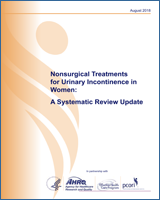From: Results

Nonsurgical Treatments for Urinary Incontinence in Women: A Systematic Review Update [Internet].
Comparative Effectiveness Review, No. 212.
Balk E, Adam GP, Kimmel H, et al.
Rockville (MD): Agency for Healthcare Research and Quality (US); 2018 Aug.
NCBI Bookshelf. A service of the National Library of Medicine, National Institutes of Health.
![Click on image to zoom This is the topology map of the network meta-analysis of all the individual compared treatments. Treatments are displayed by circles representing individual treatments or combinations of treatments, grouped together by treatment type. The interventions categories and individual interventions are: alpha agonist (duloxetine, midodrine), onabotulinum toxin A, anticholinergic (oxybutynin, solifenacin, tolterodine, tropsium, fesoterodine, flavoxate, phenylpropanolamine, propantheline, propiverine), hormones (vaginal estrogen, oral estrogen, subcutaneous estrogen, transdermal estrogen, raloxifene), neuromodulation (electroacupuncture, InterStim, magnetic stimulation, transcutaneous electrical nerve stimulation [TENS]), behavioral therapy (bladder training, education, heat therapy, pelvic floor muscle training [PFMT], bladder support, biofeedback, mindfulness-based stress reduction [MBSR], yoga, vaginal weights), periurethral bulking (polyacrylamide, collagen, autologous fat, carbonated beads, polydimethylsiloxane, porcine collagen, dextranomer hyaluronate), intravesical pressure release, and sham/no treatment/placebo. Combinations of aforementioned individual treatments are displayed, and are generally combinations between two or three treatments. Many of the combination treatments are within the behavioral therapy and neuromodulation categories. Lines between treatment circles indicate a direct study comparison of the treatments, and several of the treatment circles connect to the central sham/no treatment/placebo circle. Not all of the treatment circles are connected to each other within the treatment categories or across categories.](/books/NBK534614/bin/ch5f3.jpg)